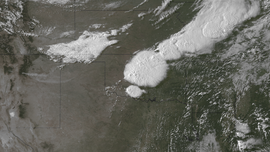Tornado outbreak of May 26–31, 2013

The storm system responsible for the tornado outbreak at 6:10 p.m. CDT May 31
|
|
| Type | Tornado outbreak |
|---|---|
| Duration | May 26–31, 2013 |
| Tornadoes confirmed | 115 |
| Max rating1 | EF3 tornado |
| Duration of tornado outbreak2 | 5 days, 10 hours, 43 minutes |
| Highest winds |
|
| Largest hail | 5.25 inches (13.3 cm) in diameter NW of Montrose, Kansas on May 27 |
| Damage | Unknown |
| Casualties | 9 fatalities confirmed (+18 non-tornadic), 172 injuries |
|
1Most severe tornado damage; see Enhanced Fujita scale 2Time from first tornado to last tornado Part of the tornadoes of 2013 |
|
1Most severe tornado damage; see Enhanced Fujita scale 2Time from first tornado to last tornado
The tornado outbreak of May 26–31, 2013 was a prolonged and widespread tornadic event that affected a large portion of the United States. The outbreak was the result of a slow-moving but powerful storm system that produced several strong tornadoes across the Great Plains states, especially in Kansas and Oklahoma. Other strong tornadoes caused severe damage in Nebraska, Missouri, Illinois, and Michigan. The outbreak extended as far as New York. 27 fatalities were reported in total, with nine resulting from tornadoes (eight in Oklahoma and one in Arkansas).
By far the most significant tornado of the outbreak was an extremely large EF3 that struck areas near the town of El Reno, Oklahoma on May 31. With a maximum width of 2.6 miles (4.2 km), it was the largest tornado on record. The second highest wind speeds recorded on Earth, around 295 miles per hour (475 km/h), were also observed in this tornado. The twister was responsible for eight deaths, including famous storm chaser Tim Samaras, his son Paul, and Carl Young as a result of being caught off-guard by the tornado's unprecedented width. In addition, the tornado caused an unknown amount of injuries.
On May 22, an upper-level low moved eastward over the Western United States, with forward progression limited by a blocking high around the Northern Plains and Great Lakes. With ample low-level moisture streaming north ahead of the low into an area of moderate instability, scattered severe weather was anticipated over parts of Colorado, Kansas, and Nebraska starting on May 24.
...
Wikipedia
